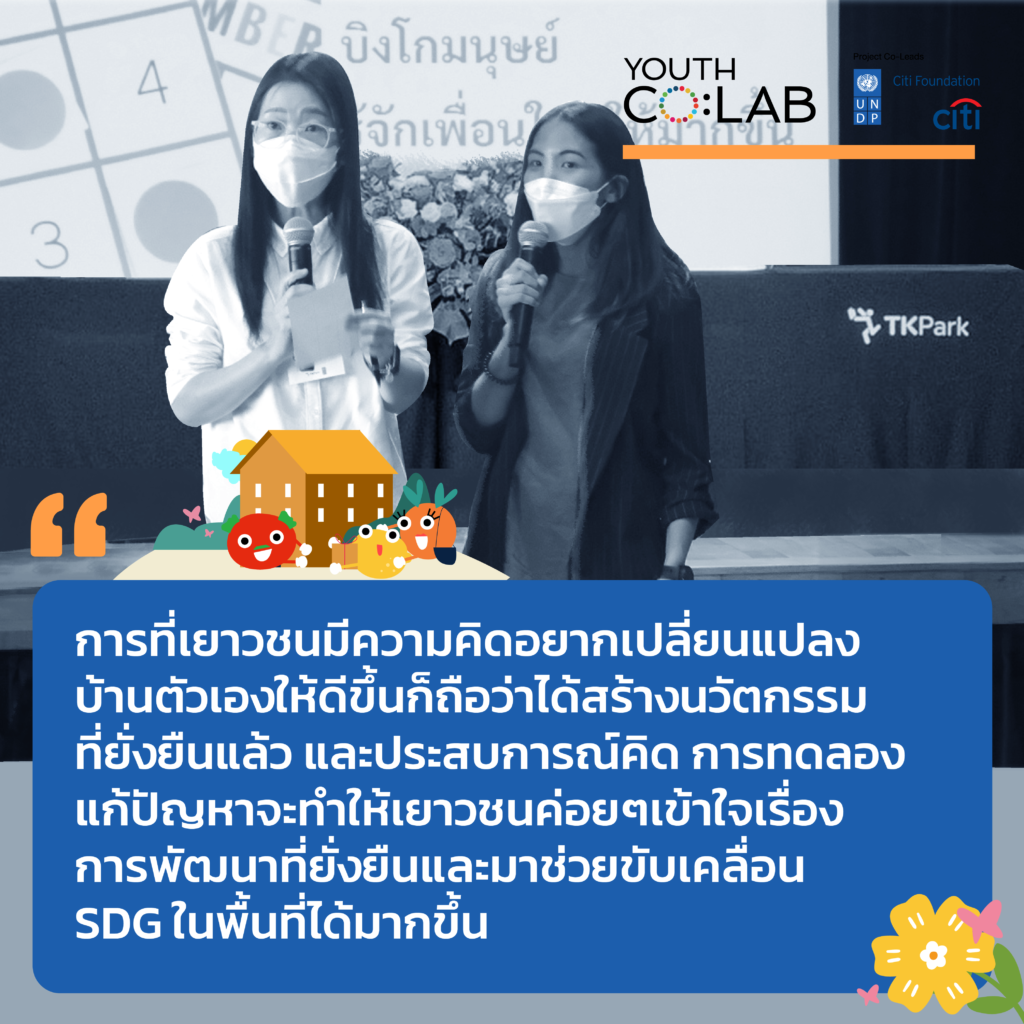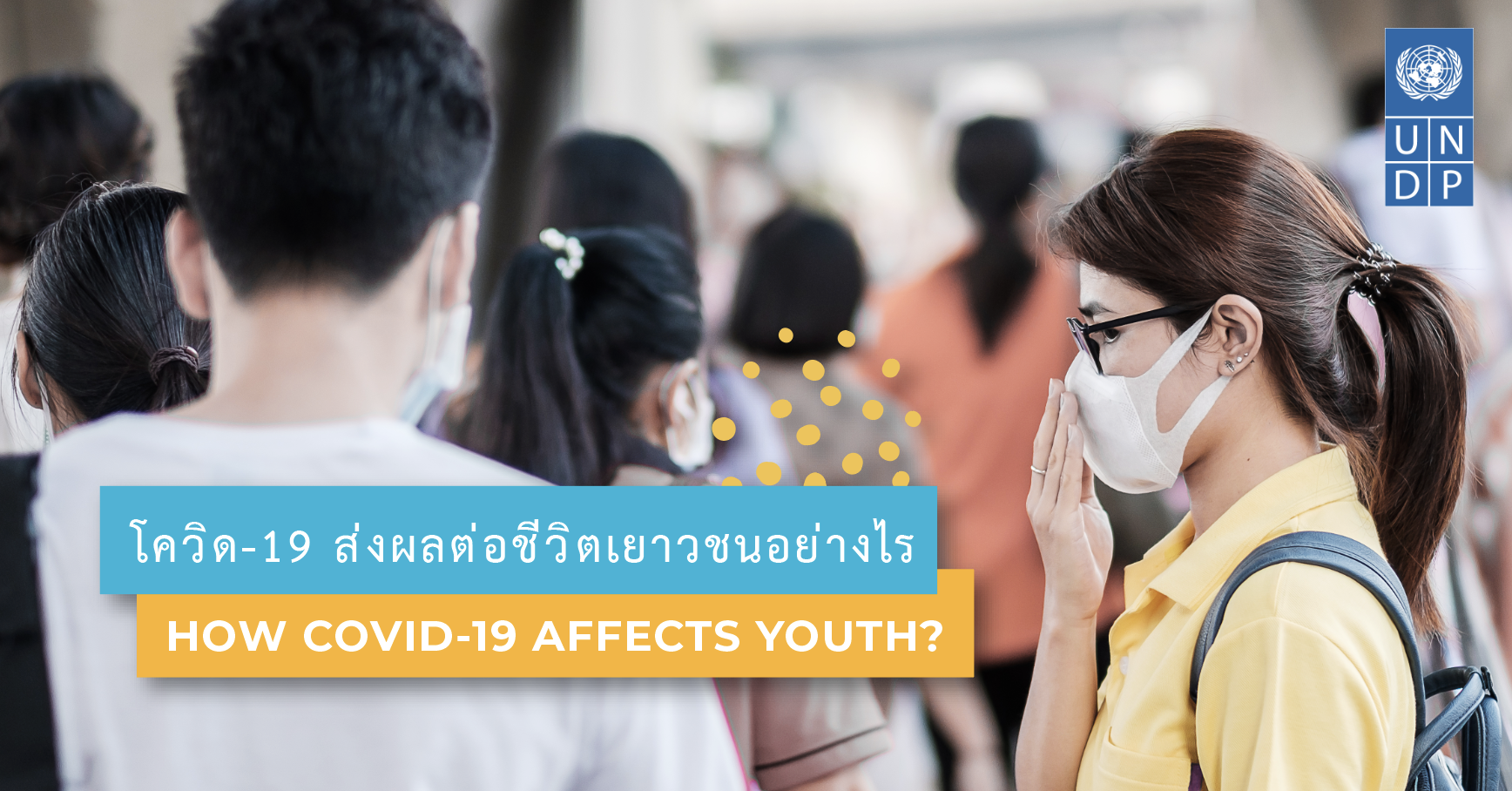
Experienced by youth, Initiated by youth, and the solutions by youth is the idea of the Youth Co:Lab, the always sphere for youth to create social innovation.
The severe global issues, the pandemic of the COVID-19, have made it easy for the organizer to select the theme that fits the society’s current challenges. The theme, the COVID-19 Recovery, has been initiated regarding the questionnaire responded by the youths across Thailand concerning their challenges during the pandemic of the COVID-19. Relatively, the sub-themes on social issues cover educational problems, economic challenges, mental illness, and gendered domestic violence.
The whole process of Youth Co:Lab consumed several months, the situation of the pandemic of the COVID-19 has been changed. During the preparation stage of the program, the pandemic of the COVID-19 was severe in Thailand. In contrast, the situation has become better on the workshop day. However, the seemingly better circumstances on the pandemic of the COVID- 19 in Thailand do not affect the program’s selected theme as there are collective issues youths have faced regardless the COVID-19 situation. However, the pandemic of the COVID-19 and the new normal did accelerate and insist on the crucial demands to tackle these social issues.
The insights on the social issues during the development process of their project has become crucial to improve and advance their project. Most significantly, the program also aims to bring together all those new generations that share similar interests on social challenges as done by all previous programs. Therefore, this article is to conclude the lesson learned that made this year’s Youth Co:Lab program successful.

Online Classroom
Learning from the experiences of organizing the previous years’ Youth Co:Lab, the staff acknowledges that the three-day program was tense and intensive for the participant to learn, develop and pitch the project under the time limitation. Thus, it was hard to expect for an obvious learning curve. The organizers, therefore, have frequently been discussing and considering organizing the program online in order to lengthen the learning period. Responsively, this year is the first year that the Youth Co:Lab has been organized online.
The increasing use of online channels for learning and meeting purposes has become normalized during the pandemic of the COVID-19. Therefore, there are possibilities to change from organizing the physical workshop to the online one. This online workshop allows us to provide more inclusive information and learning materials to the participants. The program consists of a four-day online workshop and the physical workshop of two and a half-day. As a result, the participants have an opportunity to pitch their projects that they have been developing for the entire period of almost two months.
The result of the online workshop is worthwhile, while there are some disadvantages. On one hand, the online channel offers more intensive content of the workshop. On the contrary, the organizers are aware that participants might feel more comfortable and safer to interact and exchange in person than online. However, it is found that hosting the workshop online and extending the workshop time allows the participants to feel safe to engage with each other. The continuity of the workshop eventually enhances the participants to interact, discuss, and share. The friendships, the shared interests, and commitment to transform to a better society even more greatly contribute to the relation of the participants overcoming the disadvantages of the online.
However, the online channel could not be in replacement for the in-person workshop. The organizers, therefore, decided to hold a physical workshop at the end of the programme to create a sphere for participants to exchange their interests and information, to draw out the lesson learned from the workshop and present their project that is developed according to what they have discussed and learned from the both online and offline workshop.
One more advantage of hosting the workshop online is that all the information and resources have been collected online, reducing the unnecessary repetitions of data collection. The online workshop, in addition, portrays more concrete improvement and commitment of all participants.

All support is Ready
Before the workshop starts, the organizing team has contacted the experts on several social issues to share their insights, their expertise, and to reflect on the projects, so the participants can advance their projects to be more efficient. Sanon Wangsrangboon, Co-founder of Locall, has provided the suggestion on the employment creation in the restaurant industry during the pandemic of the COVID – 19. Dr. Rangsan Wiboonuppatum, an education officer from UNICEF, also provided consultations on educational innovation in the workshop.
This year is the first year that the workshop has been supported by the Youth Co:Lab alumni to be the mentors or supporters for each group. The mentors are responsible for answering any possible questions that the participants might have, providing suggestions, and strengthening the group project.
One of the mentors who was a participant from last year Youth Co:Lab revealed that while helping and providing suggestions to improve the project, it is an opportunity to learn the more updated innovation, which is more intensive and different from last year.

What’s inside the online workshop?
Thank you to HandUp Network and ChangeFusion to help us facilitate in the processes of the four-week online workshop. In the first week, along with the ice-breaking activities to enhance the engagement and learning environment, participants have a chance to meet and introduce themselves. The first classroom’s main objective is to provide an understanding of the problems that their solutions are to be solved.
The tool, problem tree, used to create an understanding of the problems does not provide only the current situations that the team is interested in but also the understanding of the root of the problems and a well-rounded understanding of their impacts.
After seeing through the problems, each group of participants was assigned to do the stakeholder mappings and figure out what each stakeholder does. This step helps the participants to appropriately situate themselves in the problem nexus and focus on the main problem.
The session ends with solidating the problem statement to clearly define the territory of the project that each group is coping with.
The first-day online class is very intensive and strict with a short break. The reflection on the program has been used to improve the next class to be more flexible.
The second online workshop is about ideation. Because all the team has already prepared their ideas since their application, the session focuses more on revising their ideas, finding pros and cons, and identifying the significance of their innovation.
To make the participant not too exhausted with their project, the Ice Breaking activities have focused more on the interaction and share information of the participants on general topics so that they can be away from the central theme of their work for a short while.
The third online class is about learning business plan through the Business Model Canvas. The content is sophisticated and complicated, so the session’s central idea is to remind the participants not to forget the business side of the innovation, which will ensure the creation of the innovation and sustain the innovation.
When each team has a clear picture of the problem, finds some ideas to solve the problem, and recognizes the importance of the business part, the last online class discusses the social impacts under the Theory of Change.
Once each team can identify their expected social impact, each team is asked to make a reverse plan from one-year estimated outcomes to six months and provide more details on milestone activities and action plans that will bring success to the project.
The online workshop does only aim for providing inputs to develop an innovative project for each team, but to build the social transformer network of the youth. During the workshop, the political movement in Thailand is very intense. Therefore, the organizing team provides the space for discussing the current situation under the safe and respectful environment to express opinions. The organizing team believes that creating social innovation while ignoring the current social issues may be unavailing.

Our First Meet
One of the purposes of the Youth Co:Lab is to create a network between participants, supporters, and all stakeholders.
Even though the learning session about the tool used in developing innovation has been completed online, the meeting and exchange in person have been performed. This is the purpose of the organizers to bring all participants to meet in person.
Almost all the participants agreed that meeting all the workshop participants in person is the most impressive part. Participants meet with diverse groups of people such as Pkakenyaw from Mae Hong Sorn province, Muslim youth from the three-southeast provinces of Thailand, and youth from the central part of Thailand. All the participants have different skills and interests so that they can share their views and experiences. This helps to broaden their viewpoints and to learn about different cultural contexts and backgrounds.

Ideas Become True
During the meeting between the participants, the organizer team has invited the Social Entrepreneurs who have succeeded in business and created the social impact to share their experiences to inspire and become the participant’s motivation to continue their project. Some of the social entrepreneurs are the alumni of the Youth Co:Lab, such as Thanakorn Promyot, the co-founder of Yonghappy (Youth Co:Lab alumni 2017), and Sarocha Tiansri, co-founder of Pa’ Learn (Youth Co:Lab alumni 2019).
Before the last day of the program, each team reviewed the status of their projects and learned about the SDGs where each team got to apply the concept of inclusive society to their projects as well as considering the economic, social, and environmental impacts. Even though the SDGs are not obligated in this presentation, it increases each team’s awareness to review their project, whether it leads to sustainable and inclusive transformation.
One of the participants mentioned that the session on SDGs is one of the most impressive sessions because it helps to broaden the direction of the project and find the possibility of the project to be more inclusive.

Project Presentation
The end of the first phase is when the participants pitched their project to the committee and other participants. The presentation provided crucial information to help the audiences understand and find social innovation, which has been eagerly developed during the program with the challenges on time limitation, beneficial.
Before presenting the project, issues that should be included, and examples of the effective presentation methods and strategies have been suggested. The suggestions will be only the guides that the participants can adopt, apply and design if they fit with their innovations. The presentation is not only for the contest, but the organizers hope that it will be an excellent opportunity for the participants to narrate the problems that they or their relatives or friends experience in their everyday lives. The organizers also hope that the participants can summarize the ideas and knowledge from the workshop and share it with other participants.
All ten team have developed their projects, and they have their work plan ready to be implemented and eventually, achieve their goals. Even though only five out of ten teams will receive the funds to trial their project for three months, it does not mean that all the team will gain nothing from their work developed along with the program. They are able to further their projects in several ways, such as making a prototype from their idea, finding a new partner in the program to proceed with their projects, or making a proposal to the other activities or other opening opportunities.
This project could not be successful without the collaboration from the enthusiastic youth who apply for this program. We are thankful for our partners, Citi Foundation, UNICEF,Thailand Institute of Justice, True Incube, and the National Innovation Agency (NIA) for their collaboration on organizing the program, providing multidiscipline knowledge to the participants. We are very grateful to the facilitators from the Hand Up Network and the Changefusion for their hard work on instructing and supporting all ten teams throughout the program.
What are the stories behind the five selected team, who will benefit from their innovation, and how will the innovation solve these particular social problems? It will be narrated in the next articles. Please stay tuned!



































